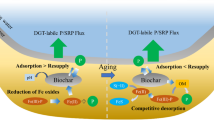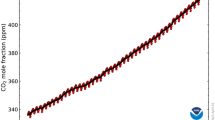Abstract
Fe-rich smectite is ubiquitous in soil environments and closely linked to the fate and mobility of hazardous trace metals and particularly to the variations in the biogeochemical redox reactions of structural Fe that determine the sorption and desorption properties of clay minerals. The biotic/abiotic redox reactions of a Fe-rich smectite, nontronite (NAu-1), were performed at various reaction times using the Fe-reducing bacterium Shewanella oneidensis MR-1 at 30°C and Na-dithionite (Na2S2O4), respectively. The extent of biotic Fe-reduction of NAu-1 after 30 days of incubation reached up to 10.7% of total Fe and the range of abiotic Fe-reduction varied from 4.9–46.6% at reaction times of 5 min, 30 min, 1 h, and 4 h. The biotically and abiotically Fe-reduced NAu-1 samples were spiked with Pb concentrations of 0.07, 0.2, 0.5, and 1.0 mg/kg and incubated under aerobic or anaerobic conditions for 24 h.
The amounts of Pb in the supernatants were analyzed using an Inductively Coupled Plasma Mass Spectrometer (ICP-MS) and Multi-collector (MC)-ICP-MS. The amounts of Pb removed from the supernatants were negatively related to the extent of Fe(III) reduction in the abiotically Fe-reduced NAu-1 samples. In contrast, less Pb (~15%) was removed from the biotically Fe-reduced NAu-1 samples with a similar extent of Fe(III) reduction. Changes in the isotopic 208/204Pb ratio indicated that the lighter 204Pb isotope was preferentially adsorbed to the NAu-1 samples with less Fe reduction and indicated that variations in the net layer charge affected isotopic fractionation. Significant differences in the 208/204Pb ratios for NAu-1 samples that were biotically Fe-reduced under anaerobic conditions were measured and indicate that the reversibility of the structural/chemical modifications that occur under redox conditions can affect Pb removal and, thus, isotope fractionation. These results collectively infer that the biogeochemical properties of clay minerals should be considered in order to understand the fate of trace metals in natural environments.
Similar content being viewed by others
References
Benjamin, M.M. and Leckie, J.O. (1981) Multiple-site adsorption of Cd, Cu, Zn, and Pb on amorphous iron oxyhydroxide. Journal of Colloid and Interface Science, 79, 209–221.
Bhattacharyya, K.G. and Gupta, S.S. (2006) Kaolinite, montmorillonite, and their modified derivatives as adsorbents for removal of Cu(II) from aqueous solution. Separation and Purification Technology, 50, 388–397.
Bishop, M.E., Glasser, P., Dong, H., Arey, B., and Kovarik, L. (2014) Reduction and immobilization of hexavalent chromium by microbially reduced Fe-bearing clay minerals. Geochmica et Cosmochimica Acta, 133, 186–203.
Cheng, H. and Hu, Y. (2010) Lead (Pb) isotopic fingerprinting and its applications in lead pollution studies in China: A review. Environmental Pollution, 158, 1134–1146.
Chisholm-Brause, C.J., Berg, J.M., Matzner, R.A., and Morris, D.E. (2001) Uranium(VI) sorption complexes on montmorillonite as a function of solution chemistry. Journal of Colloid and Interface Science, 233, 38–49.
Choi, J.W., Yoo, E.J., Kim, J.Y., Hwang, J.Y., Lee, K., Lee, W.S., Han, J.S., and Lee, K.S. (2013) Pb concentrations and isotopic compositions in the soil and sediments around the abandoned mine in southwest of Korea. Journal of Agricultural Chemistry and Environment, 2, 101–108.
Dong, H., Jaisi, D.P., Kim, J.W., and Zhang, G. (2009) Microbe-clay mineral interactions. American Mineralogist, 94, 1505–1519.
Gadde, R. and Laitinen, H.A. (1974) Studies of heavy metal adsorption by hydrous iron and manganese oxides. Analytical Chemistry, 46, 2022–2026.
Gupta, S.S. and Bhattacharyya, K.G. (2008) Immobilization of Pb(II), Cd(II) and Ni(II) ions on kaolinite and montmorillonite surfaces from aqueous medium. Journal of Environmental Management, 87, 46–58.
Jaisi, D.P., Dong, H., Kim, J.W., He, Z., and Morton, J.P. (2007) Nontronite particle aggregation induced by microbial Fe(III) reduction and exopolysaccharide production. Clays and Clay Minerals, 55, 96–107.
Jaisi, D.P., Ji, S., Dong, H., Blake, R.E., Eberl, D.D., and Kim, J.W. (2008) Role of microbial Fe(III) reduction and solution chemistry in aggregation and settling of suspended particles in the Mississippi river delta plain, Louisiana, USA. Clays and Clay Minerals, 56, 416–428.
Jaisi, D.P., Dong, H., Plymale, A.E., Fredrickson, J.K., Zachara, J.M., Heald, S., and Liu, C. (2009) Reduction and long-term immobilization of technetium by Fe(II) associated with clay mineral nontronite. Chemical Geology, 264, 127–138.
Jiang, M., Jin, X., Lu, X., and Chen, Z. (2010) Adsorption of Pb(II), Cd(II), Ni(II) and Cu(II) onto natural kaolinite clay. Desalination, 252, 33–39.
Kersten, M., Garbe-Schoenberg, C.D., Thomsen, S., Anagnostou, C., and Sioulas, A. (1997) Source apportionment of Pb pollution in the coastal waters of Elefsis Bay, Greece. Environmental Science & Technology, 31, 1295–1301.
Kim, J.W., D ong, H., Seabaugh, J., Newell, S.W., and Eberl, D.D. (2004) Role of microbes in the smectite-to-illite reaction. Science, 303, 830–832.
Kim, J.W., Furukawa, Y., Dong, H., and Newell, S.W. (2005) The effect of microbial Fe(III) reduction on smectite flocculation. Clays and Clay Minerals, 53, 572–579.
Komlos, J., Peacock, A., Kukkadapu, R.K., and Jaffé, P.R. (2008) Long-term dynamics of uranium reduction/reoxidation under low sulfate conditions. Geochimica et Cosmochimica Acta, 72, 3603–3615.
Komadel, P., Madejova, J., and Stucki, J.W. (1995) Reduction and reoxidation of nontronite: Questions of reversibility. Clays and Clay Minerals, 43, 105–110.
Koo, T.H., Jang, Y.N., Kogure, T., Kim, J.H., Park, B.C., Sunwoo, D., and Kim, J.W. (2014) Structural and chemical modification of nontronite associated with microbial Fe(III) reduction: Indicators of “illitization.” Chemical Geology, 377, 87–95.
Lee, K., Kostka, J.E., and Stucki, J.W. (2006) Comparisons of structural iron reduction in smectites by bacteria and dithionite: An infrared spectroscopic study. Clays and Clay Minerals, 54, 197–210.
Lu, P., Nuhfer, N.T., Kelly, S., Li, Q., Konishi, H., Elswick, E., and Zhu, C. (2011) Lead coprecipitation with iron oxyhydroxide nano-particles. Geochimica et Cosmochimica Acta, 75, 4547–4561.
MacKenzie, A.B. and Pulford, I.D. (2002) Investigation of contaminant metal dispersal from a disused mine site at Tyndrum, Scotland, using concentration gradients and stable Pb isotope ratios. Applied Geochemistry, 17, 1093–1103.
McKinley, J.P., Zachara, J.M., Smith, S.C., and Turner, G.D. (1995) The influence of uranyl hydrolysis and multiple sitebinding reactions on adsorption of U(VI) to montmorillonite. Clays and Clay Minerals, 43, 586–598.
Myers, C.R. and Nealson, K.H. (1988) Bacterial manganese reduction and growth with manganese oxide as the sole electron acceptor. Science, 240, 1319–1321.
Neumann, A., Oslon, T.L., and Scherer, M. (2013) Spectroscopic evidence for Fe(II)-Fe(III) electron transfer at clay mineral edge and basal sites. Environmental Science & Technology, 47, 6969–6977.
Pentrakova, L., Su, K., Pentrak, M., and Stucki, J.W. (2013) A review of microbial redox interactions with structural Fe in clay minerals. Clay Minerals, 48, 543–560.
Plus, R.W., Powell, R.M., Clark, D., and Eldred, C.J. (1991) Effects of pH, solid/solution ratio, ionic strength, and organic acids on Pb and Cd sorption on kaolinite. Water, Air, and Soil Pollution, 57–58, 423–430.
Ribeiro, F.R., Fabris, J.D., Kostka, J.E., Komadel, P., and Stucki, J.W. (2009) Comparisons of structural iron reduction in smectites by bacteria and dithionite: II. A variabletemperature Mössbauer spectroscopic study of Garfield nontronite. Pure and Applied Chemistry, 81, 1499–1509.
Rosman, K.J.R., Chisolm, W., Boutron, C.F., Candelone, J.P., and Patterson, C.C. (1994) Anthropogenic lead isotopes in Antarctica. Geophysical Research Letters, 21, 2669–2672.
Singh, R., Dong, H., Zeng, Q., Zhang, L., and Rengasamy, K. (2017) Hexavalent chromium removal by chitosan modifiedbioreduced nontronite. Geochimica et Cosmochimica Acta, 210, 25–41.
Stucki, J.W. (1981) The Quantitative assay of minerals for Fe2+ and Fe3+ using 1,10-phenanthroline: II. A photochemical method. Soil Science Society of America Journal, 45, 638–641.
Stucki, J.W., Golden, D.C., and Roth, C.B. (1984) Preparation and handling of dithionite-reduced smectite suspensions. Clays and Clay Minerals, 32, 191–197.
Swallow, C.K., Hume, D.N., and Morel, F.M.M. (1980) Sorption of copper and lead by hydrous ferric oxide. Environmental Science & Technology, 11, 1326–1331.
Tanabe, K. (2012) Solid Acids and Bases: Their Catalytic Properties. Elsevier, Amsterdam.
Tsunashima, A., Brindley, G.W., and Bastovanov, M. (1981) Adsorption of Uranium from solutions by montmorillonite: Compositions and properties of uranyl montmorillonites. Clays and Clay Minerals, 29, 10–16.
Zhang, G., Dong, H., Kim, J.W., and Eberl, D.D. (2007). Microbial reduction of structural Fe3+ in nontronite by a thermophilic bacterium and its role in promoting the smectite to illite reaction. American Mineralogist, 92, 1411–1419.
Author information
Authors and Affiliations
Corresponding author
Rights and permissions
About this article
Cite this article
Koo, Th., Kim, Jy., Choi, Jw. et al. The Effects of Biogeochemical Modification of Fe-Rich Smectite on the Fate of Pb. Clays Clay Miner. 65, 410–416 (2017). https://doi.org/10.1346/CCMN.2017.064080
Received:
Revised:
Published:
Issue Date:
DOI: https://doi.org/10.1346/CCMN.2017.064080




